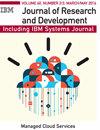Building a high-performance resilient scalable storage cluster for CORAL using IBM ESS
IF 1.3
4区 计算机科学
Q1 Computer Science
引用次数: 0
Abstract
A high-performance, scalable, and resilient storage subsystem is essential for delivering and maintaining consistent performance and high utilization expected from a modern supercomputer. IBM delivered two systems under the CORAL program, both of which used IBM Spectrum Scale and IBM Elastic Storage Server (ESS) as the storage solution. The larger of the two CORAL clusters is composed of 77 building blocks of ESS, each of which consists of a pair of high-performance I/O Server nodes connected to four high-density storage enclosures. These ESS building blocks are interconnected via a redundant InfiniBand EDR network to form a storage cluster that provides a global namespace aggregating performance over 32,000 commodity disks. The IBM Spectrum Scale for ESS runs high-performance erasure coding on each building block and provides a single global name space across all the building blocks. The IBM Spectrum Scale features deliver a highly resilient, high-performance storage subsystem using ESS. These features include recent improvements for efficient buffer management and fast efficient low-latency communication. CORAL I/O performance results include large-block streaming throughput of over 2.4 TB/s, ability to create over 1 M 32-KB files per second, and enabling an aggregate rate of 30 K zero-length file creates per second in a shared directory from multiple nodes. This article describes the design and implementation of the ESS storage cluster; the innovations required to meet the performance, scale, manageability, and reliability goals; and challenges we had to overcome as we deployed a system of such unprecedented I/O capabilities.使用IBM ESS为CORAL构建高性能弹性可扩展存储集群
高性能、可扩展和弹性存储子系统对于交付和维护现代超级计算机所期望的一致性能和高利用率至关重要。IBM在CORAL项目下交付了两个系统,它们都使用IBM Spectrum Scale和IBM Elastic Storage Server (ESS)作为存储解决方案。较大的CORAL集群由77个ESS模块组成,每个模块由一对高性能I/O Server节点连接到4个高密度存储框。这些ESS构建块通过冗余的ib EDR网络相互连接,形成一个存储集群,提供超过32,000个商品磁盘的全局命名空间聚合性能。用于ESS的IBM Spectrum Scale在每个构建块上运行高性能擦除编码,并提供跨所有构建块的单一全局名称空间。IBM Spectrum Scale特性使用ESS提供了一个高弹性、高性能的存储子系统。这些特性包括对高效缓冲区管理和快速高效低延迟通信的最新改进。CORAL I/O性能结果包括超过2.4 TB/s的大块流吞吐量,每秒创建超过1m个32 kb文件的能力,以及在多个节点的共享目录中实现每秒30 K零长度文件创建的聚合速率。本文介绍了ESS存储集群的设计与实现;满足性能、规模、可管理性和可靠性目标所需的创新;以及我们在部署具有如此前所未有的I/O能力的系统时必须克服的挑战。
本文章由计算机程序翻译,如有差异,请以英文原文为准。
求助全文
约1分钟内获得全文
求助全文
来源期刊

IBM Journal of Research and Development
工程技术-计算机:硬件
自引率
0.00%
发文量
0
审稿时长
6-12 weeks
期刊介绍:
The IBM Journal of Research and Development is a peer-reviewed technical journal, published bimonthly, which features the work of authors in the science, technology and engineering of information systems. Papers are written for the worldwide scientific research and development community and knowledgeable professionals.
Submitted papers are welcome from the IBM technical community and from non-IBM authors on topics relevant to the scientific and technical content of the Journal.
 求助内容:
求助内容: 应助结果提醒方式:
应助结果提醒方式:


